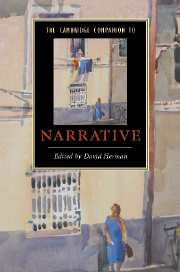Book contents
- Frontmatter
- Part I Preliminaries
- Part II Studying narrative fiction: a starter-kit
- Part III Other narrative media (a selection)
- 9 Conversational storytelling
- 10 Drama and narrative
- 11 Film and television narrative
- 12 Narrative and digital media
- Part IV Further contexts for narrative study
- Glossary
- Further reading
- Index
9 - Conversational storytelling
from Part III - Other narrative media (a selection)
Published online by Cambridge University Press: 28 September 2007
- Frontmatter
- Part I Preliminaries
- Part II Studying narrative fiction: a starter-kit
- Part III Other narrative media (a selection)
- 9 Conversational storytelling
- 10 Drama and narrative
- 11 Film and television narrative
- 12 Narrative and digital media
- Part IV Further contexts for narrative study
- Glossary
- Further reading
- Index
Summary
Introduction
Conversation is the natural home of narrative, and the most familiar context of storytelling for most of us. Storytelling is a common part of conversation between friends and family members. We tell stories to make a point, to catch up on each other's lives, to report news, and to entertain each other. And one story opens the floor to other participants for stories of their own. Our conversational stories are embedded in their local contexts, their forms and functions developing from and reflecting these contexts.
Conversational storytelling is not simply oral storytelling. Much of the research on oral narrative is based on stories from non-conversational contexts. Research on oral storytelling began with monologic stories explicitly elicited in interviews, and much recent work maintains this tradition, while other scholars have investigated narratives produced as retellings of films, picture stories, or stories previously read. Stories in everyday conversational contexts share some but clearly not all characteristics with these other oral genres. Genuine conversational storytelling is always interactive, negotiated, and not simply designed for a particular audience by a single teller; indeed, it is often hard to determine even who is the primary teller, especially when the events were jointly experienced or the basic story is already familiar. Conversational stories may be deeply contextualized, diffuse, and not easily detachable from the local conditions that occasion them or understandable outside of them.
- Type
- Chapter
- Information
- The Cambridge Companion to Narrative , pp. 127 - 141Publisher: Cambridge University PressPrint publication year: 2007
- 58
- Cited by

